The south of France is one of the most prestigious regions in Europe with their fine wine, the Cote d’Azur and its rich people, many tourists go to cities like Monaco and Nice for their holidays in the summer.
But it’s not just a tourist destination; the region also has a lot of football to offer, especially with Olympique Marseille, AS Monaco and OGC Nice.
Nice have been on an up-and-down trajectory over the last couple of years, alternating between fifth and ninth place over the course of the last four seasons.
The club is one of the most successful in French footballing history.
Over the last couple of years, many big-name managers have been there, including Patrick Viera, Lucien Favre, Christophe Galtier, and Francesco Farioli.
The latter managed to break into the top five of the Ligue 1 once again last season but was poached by Dutch giant Ajax Amsterdam in the summer and decided to leave the Côte d’Azur after just 12 months for another opportunity.
With their coaching position vacant, OGC Nice made a move themselves and decided to poach Franck Haise from RC Lens to become their new head coach.
The 53-year-old Frenchman was the mastermind behind RC Lens’s rise from Ligue 2 to the UEFA Champions League, where he even beat Arsenal in the group stage.
While the injury-plagued team lost 4-1 against Lyon this past weekend, the club still occupies sixth place in Ligue 1 but struggles immensely in the UEFA Europa League.
In this tactical analysis and team report, we will examine Franck Haise’s style of play so far in Nice, their attacking power, and where they need to improve over the course of the season.
OGC Nice Deep Block Into Fast Counterattacks
While this article focuses on OGC Nice’s rapid attacking play under Franck Haise, we still need to examine their defensive work first.
While we are splitting up the game into four phases to better understand certain situations, football is extremely fluent, even compared to other team sports, and therefore, all four phases influence and influence each other.
Nice have not had much possession this season in Ligue 1; in fact, they don’t even reach 50% in most of their games.
Still, their attack is lethal, and they have created 21.7 non-penalty expected goals so far this season in Ligue 1, which is the third-best value behind only PSG and AS Monaco.
Other teams do not have much possession of the ball and have very potent offences, but Nice are a bit different from the rest of them.
While most of these teams use a very aggressive attacking press and counterpress to win the ball back high up the pitch and have a relatively short distance to the goal, Nice play with a deep block, especially against stronger teams.
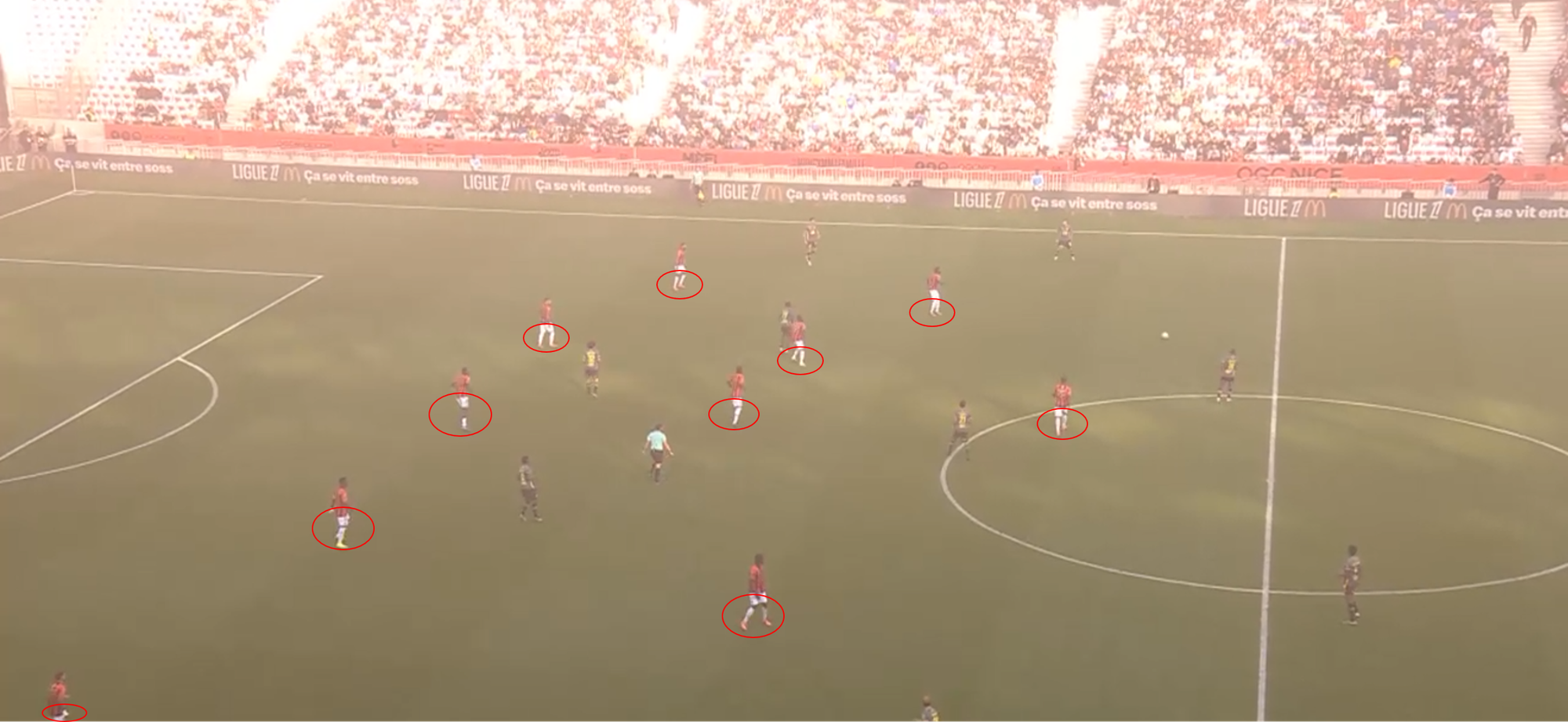
Here, we can see Nice in their block while defending.
All 11 players are working to get behind the ball, and only one striker is loosely trying to engage into a pressing situation.
Haise believes that they should not trigger the press on their own but only when their opponent is making a mistake.
Although teams nowadays prefer a more proactive approach to playing, this still proved very efficient for Nice last season under Farioli.
The team closes the centre of the field and plays in a 5-4-1 formation, which is just a more defensive version of their usual 3-4-3 formation with the ball.
They keep the distances between players rather close, especially in the middle of the field.
With their manpower, they control the midfield, not allowing the opposing team to play through the half-spaces as well.
This forces their opponents to play through their wings most of the time.
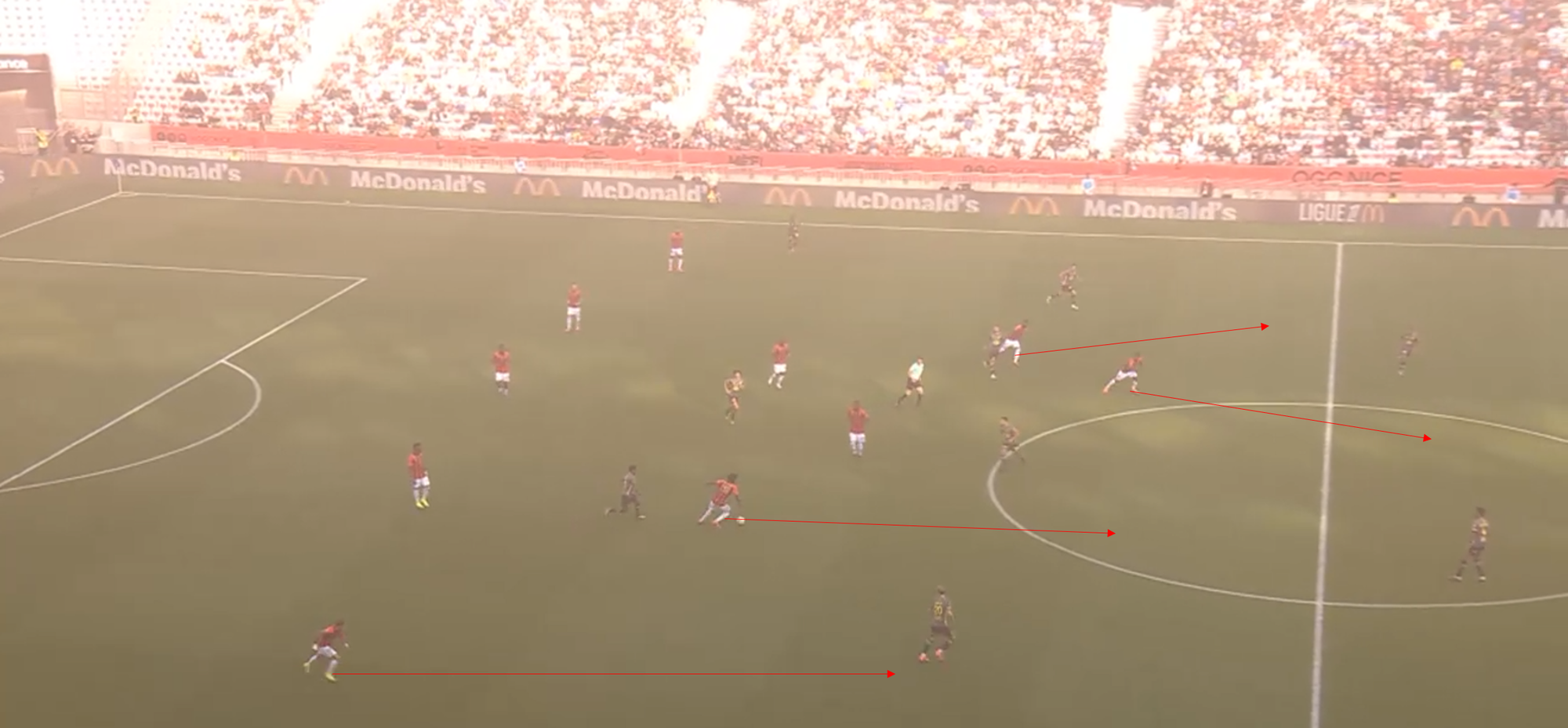
Here, Lille try to switch play from the left to the right side of the field, but Nice intercept the pass in the half-space.
Instantly, all attackers and the near-sided wing-back start to make runs behind the defensive line, moving forward at a high intensity and speed.
These types of counterattacks are one of the reasons why Nice are so lethal while attacking.
The runs are well-timed and are forcing Lille into a tough spot.
They need to apply pressure to the ball carrier with their counterpress and cover the runs made by his teammates.
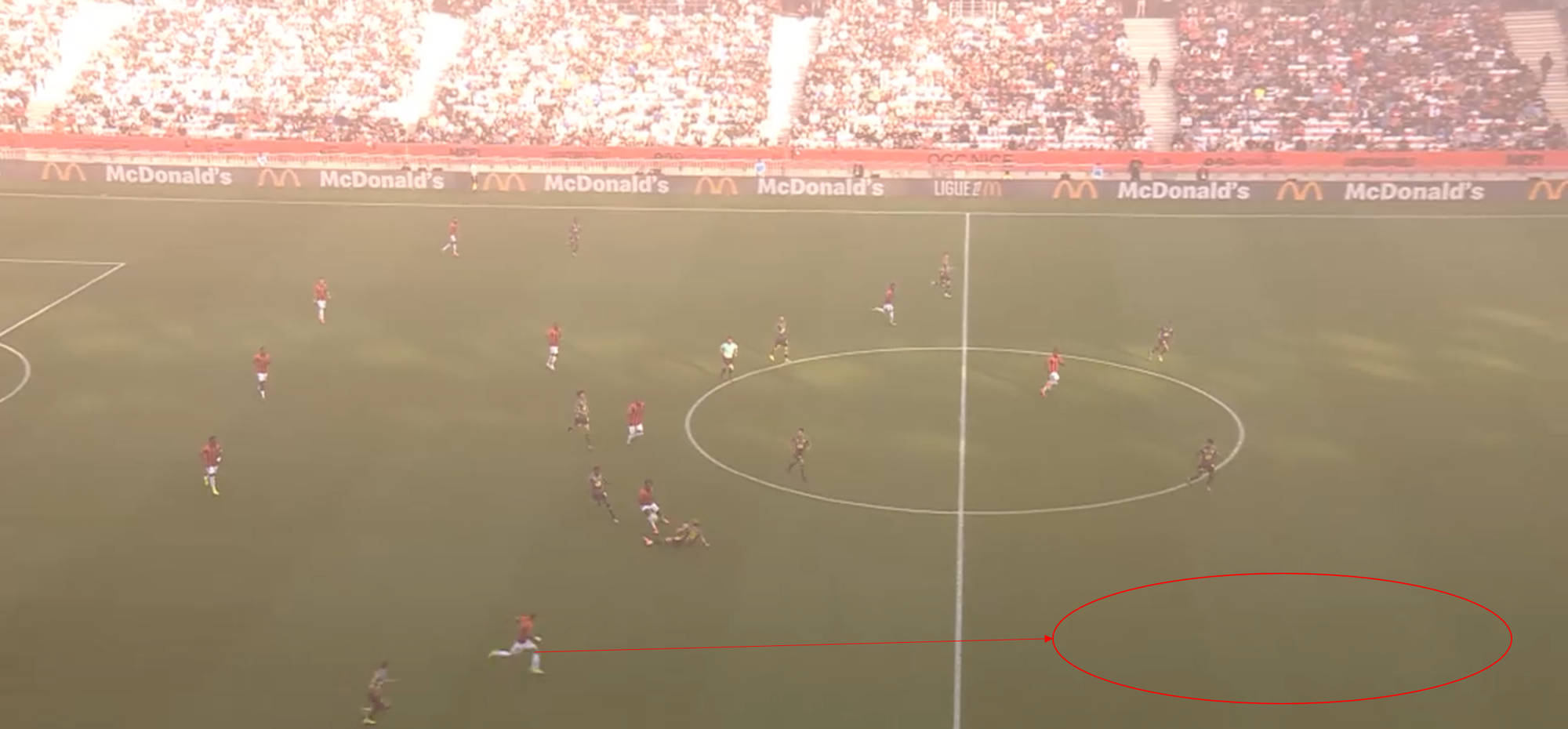
If we look at the principles that Nice is using after winning the ball from their opponent, it is very interesting to see that they are not trying to establish control of the ball with their first action after winning it; they are always on the hunt for forward or even progressive passes with their first action.
But, as in the scene above, this does not always work out, and the risk they are taking is relatively high.
The wing-back sees the space he wants to make a run into, but the midfielder already loses the ball in the midfield trying to make that pass, which means that Nice is caught off guard by the counter-counter.
This is one of the reasons Nice is struggling defensively this season.
Overall, their defensive approach hinders their attacking approach right now because the distances towards the goal are too big to cover most of the time.
OGC Nice Build-Up To Sting
Another big reason for Nice’s low possessions is their rapid build-up play.
Franck Haise’s tactics has his men playing out from the back, but they are not playing around for too long or too keen on establishing control through possession.
The team is always on its front foot, trying to play with as quick a tempo as possible in every situation.
A couple of tactical measures allow Nice to play this way.
For one, they have a lot of movement in their backline.
The centre-backs are not standing still or dropping back after playing passes; they are always keeping their momentum and moving forward to receive another pass, which is obviously not without risk but also allows for more passing options in a forward direction.
Another thing that Haise has his men doing is overloading one side in a very extreme way.
In modern football, pretty much all the coaches overload one side of the field in possession because it is an easy way to create a numerical advantage in a predetermined space.
Still, Nice is overdoing it a bit at some points.
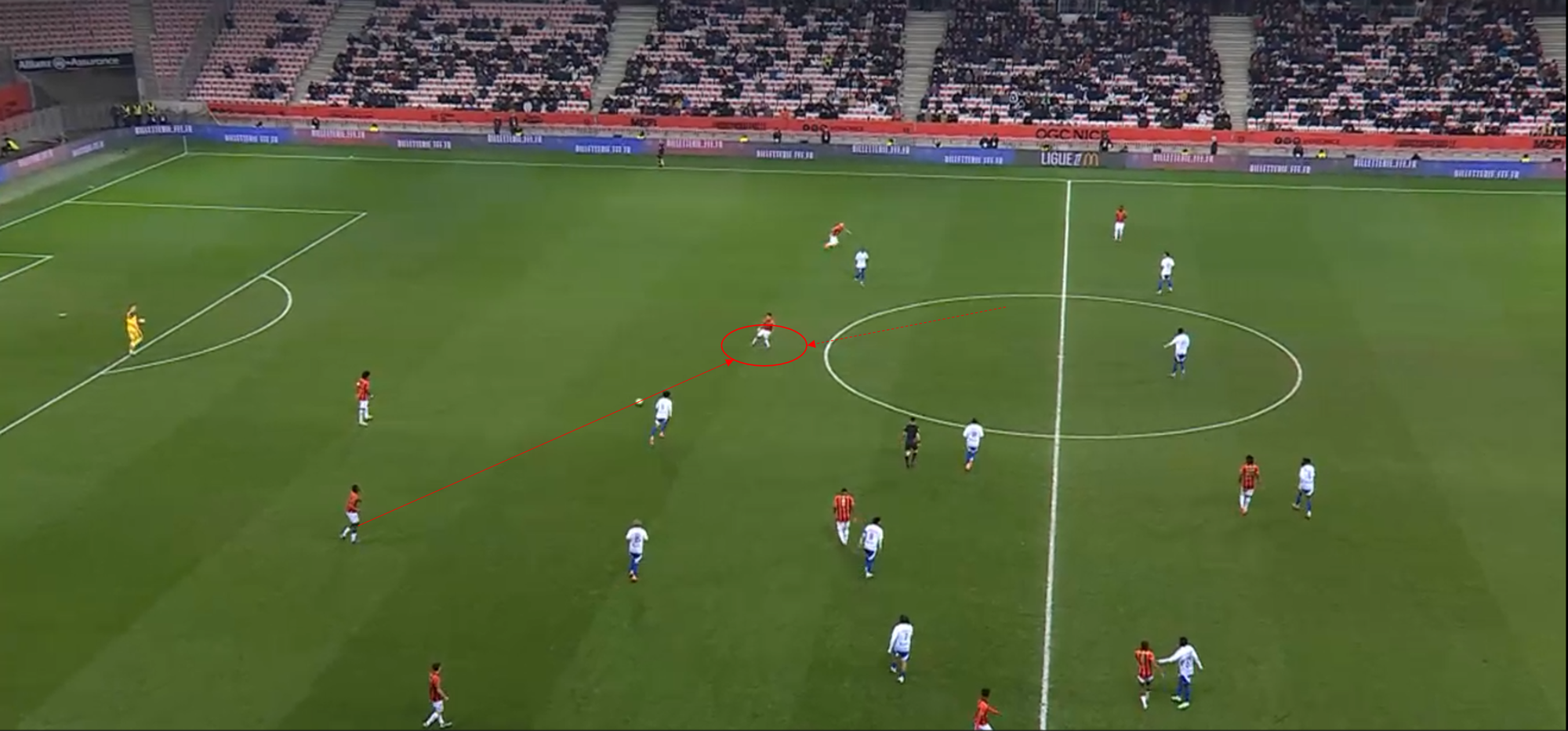
Here, we can see Nice in a build-up situation.
Seven of their ten outfield players are pushed towards the right side of the field.
The situation started with a throw-in to the centre-back, who now has the ball on the right side of the field.
Nice is not doing that.
They do play through their numbers on the right side.
However, the collective movement to one side is actually intended to open up space on the other side of the field.
With all midfielders pushing to one side, Nice has now managed to free up the far-sided half space and the left central midfielder is now covered by a centre-back who can’t step up this far.
Sofiane Diop can now drop deep himself a bit into the half-space and receive the ball in a half-open stance so he can turn towards goal with his first touch and move forward quickly.
This allows Nice to play through the first line of press here and forces their opponent to react to their play from now on with no chance of recovering control over the situation for Racing Strasbourg there.
This pattern of freeing up a midfielder in the far-sided half-space and finding diagonal passes to these midfielders is a very efficient way of building up for Nice this season.
Still, they often struggle to find different solutions to these situations and lack consistency in their play.
This means that they do not encounter these types of situations often enough.
Therefore, the team often has problems with early losses and a lack of ideas in the build-up phase of play in possession.
From there on, Nice now have an advantage on the left side of the pitch.
Overloading is an admirable principle, but it only gets really effective when combined with isolating players on the other side of the field to provoke offensive actions.
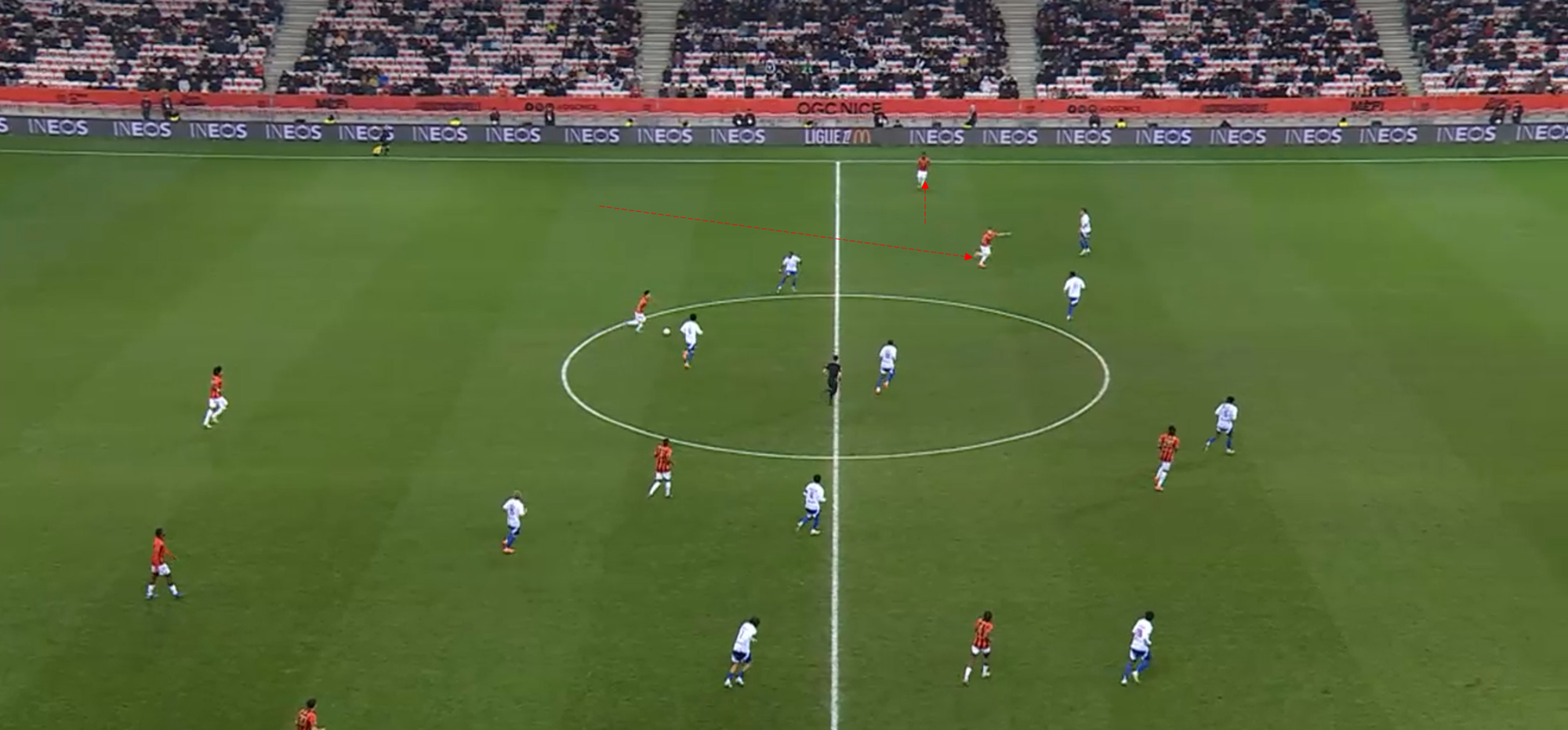
Here, left-back Melvin Bard is starting to make a run early after Diop received the ball to give him an option to his left side as well, where only one full-back and a disoriented central defender are still in contention to defend anything.
Jeremy Boga is making a clever run.
Instead of running behind the defensive line, he is moving to the outside, stretching out Strasbourg’s defenders and forcing a switch in their marking scheme.
Now the disoriented centre-back, who has his back turned towards the ball and does not even look at Bard at any point in this situation, has to cover the run from the left-back because the full-back now has to account for a pass to Boga towards the wing as well.
This creates an opportunity for a breakthrough and a through-ball for Diop.
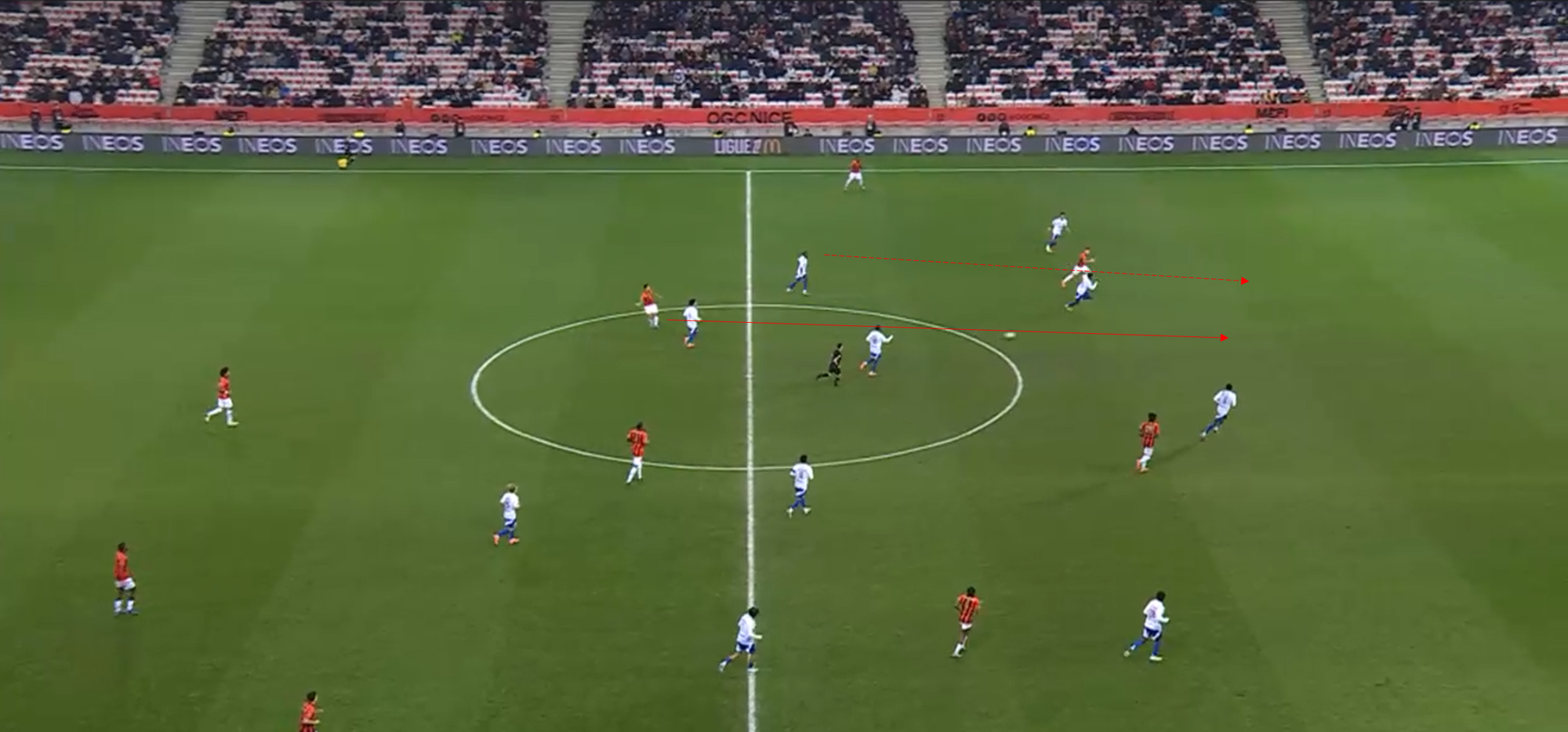
Diop now simply plays the ball right through the hole in the defensive line, where the centre-back has no shot at intercepting the pass after the earlier movement from Bard and Boga.
Bard is at full speed when the defender is just turning around, meaning that there is no shot for the defender to recover and get to the Nice player in time.
Bard scores the equaliser here and puts Nice back level in a very tight game in a situation that started with a throw-in in their own half.
Ten seconds and two passes, and Nice was able to score.
That was incredibly efficient football from Haise’s team.
These situations show the team’s great ability to pick up the pace quickly and cover a great deal of distance in a short period of time.
Their runs are well-timed, and they have many pacey players.
Their players do well in the half spaces, and when isolated, the attackers are never afraid of taking on defenders after receiving the ball.
Still, the team needs to find more consistency.
Their fast-paced playing style also comes with a lot of risks, and at the moment, the team is ending up with early losses a tad too often, which puts them on the back foot in some games.
OGC Nice Finishing
Another strong suit for Nice and Franck Haise this season has been their efficiency in attack.
Not necessarily in terms of chance conversion, the team ranks below average there, but in terms of actually finishing off their attacking efforts with a shot.
While they do not have many possessions or attacks per game, they still rank in the top five amongst shots in Ligue 1 this season.
This shows that most of their attacks at least attempt to score.
With their good npxG-value factored in, we can say that their shots are not just some bad shots from distance but actually decent goal-scoring opportunities.
Looking at their playing style, we can see some things helping them achieve this feat.
Their fast-paced playing style also helps them here because they are catching their opponents off-guard rather often, but there is more to it.
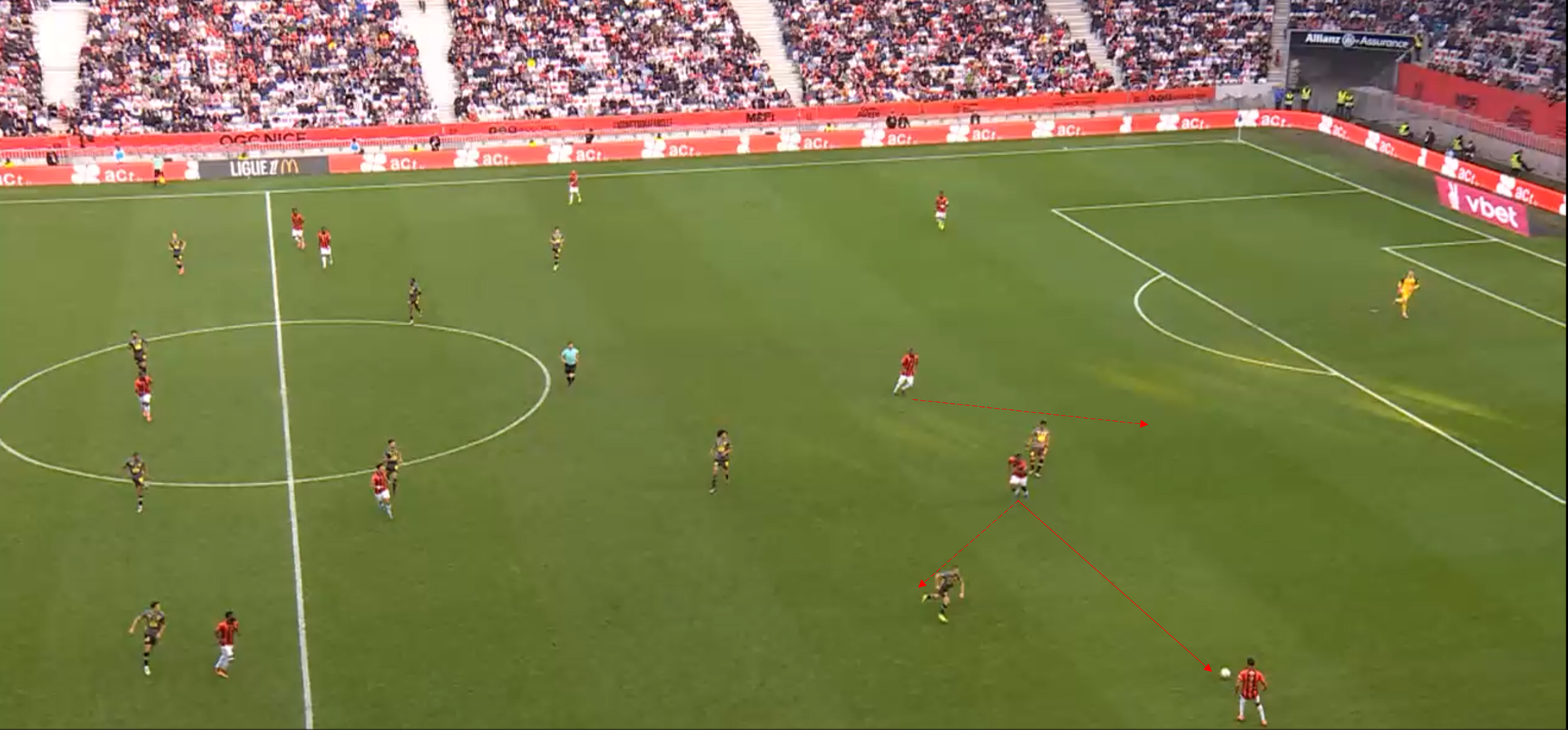
Here, we can see the build-up of Nice once again.
After receiving it from the middle centre-back, the left centre-back has the ball and does not stand still after passing but moves forward instantly, dragging one midfielder out towards him.
The holding midfielder drops back into the backline to be the safety net here and gives Nice an easy out-option, but they are not using that here.
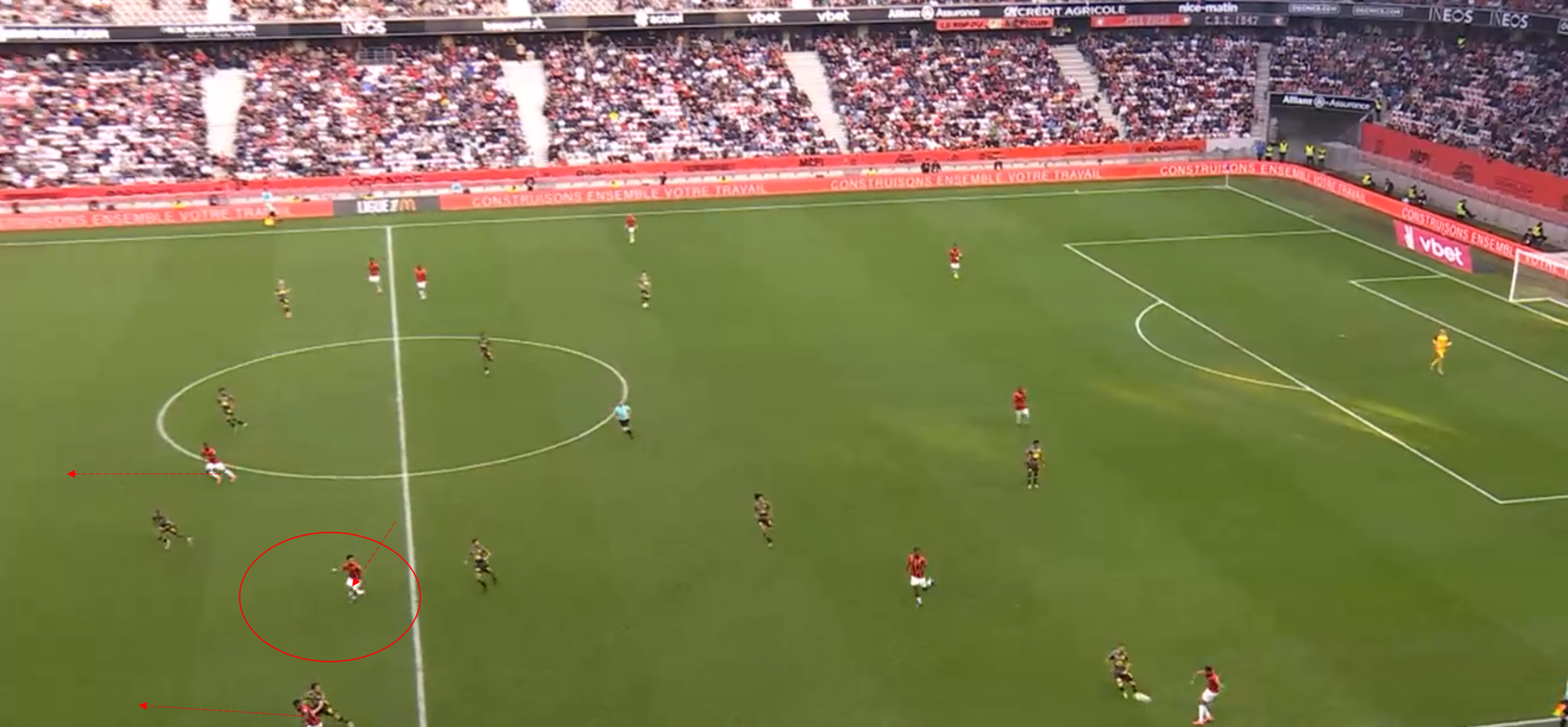
Haise has his men looking forward, and with just a little movement of the centre-back and the holding midfielder, the team has once again created space for Diop, this time right in front of the defensive line on the near side of the field.
The other attackers are making runs behind the defensive line.
Also, once again, Haise has his men overloading one die of the file, this time with many players on the left side.
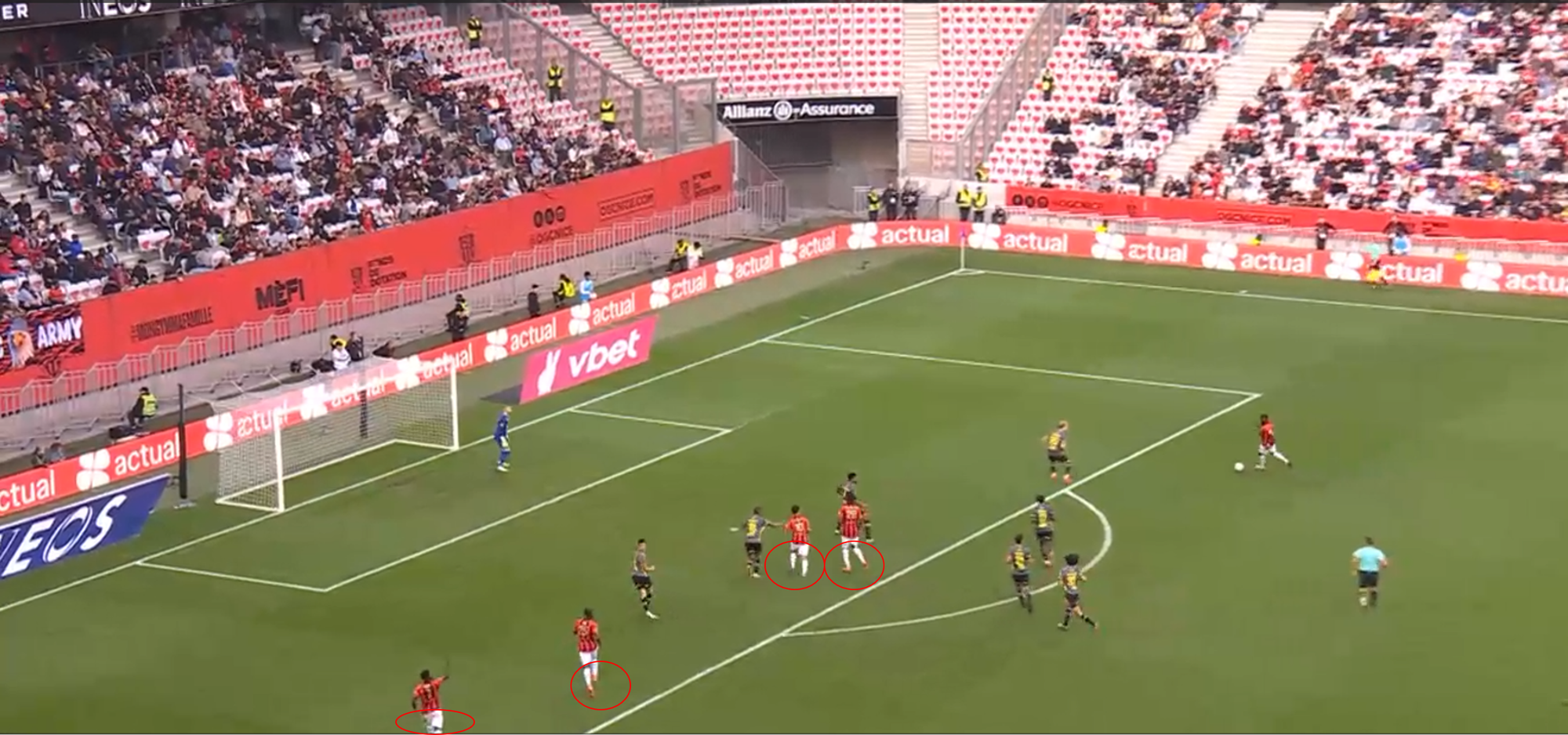
In the end, Diop switches the ball after a nice take-on to the right side of the field, where his full-back and winger were making runs.
Looking into the box, Haise has his men forward with a huge number advantage.
Two players are uncovered at the far post, and two more are right in the middle of the box, making a total of four men in the box.
This is a trend that Nice have done incredibly well this season.
Their numbers moving forward are always really good, which enables them to find a player in the box with crosses often, resulting in many shots.
Here, the full-back, who is not yet in the picture, is making an overlapping run and putting the ball into the box.
Diop then gets to the ball first in the six-yard box and has an easy tap-in finish to put his team in the lead against LOSC.
Having a presence in the box is a key part of a team like OGC Nice, and Franck Haise ensures that they are always good in that regard, enabling their attack even further.
Conclusion
OGC Nice was facing trouble in the summer after Ajax poached their coach, Francesco Farioli.
This left the team with an uncertain future once again after a good season.
Franck Haise has steadied the ship quickly, however, and is managing his team to a decent sixth place at the moment.
The team is very good at attacking at a high pace.
Their build-up is structured so that they can always keep the flow going and attack within a couple of seconds.
Haise also has his men working with a great presence in the box, allowing them to finish off their attacks efficiently.
Still, the team also has some troubles, especially the distance towards the goal while defending in their deep block, which is a problem when counterattacking.
The team could be a bit more aggressive against the ball.
Currently, the team is riddled with injuries and got pushed out of fifth place by a strong Lyon side, but with all players healthy, Nice should be able to target the European ranks in Ligue 1 once more.
Speaking of European football, their performances in the UEFA Europa League have been abysmal, and the team needs to work on improving their performance as quickly as possible.
Overall, Franck Haise has done a decent job, but there still is a lot of potential there at the Cote d’Azur.

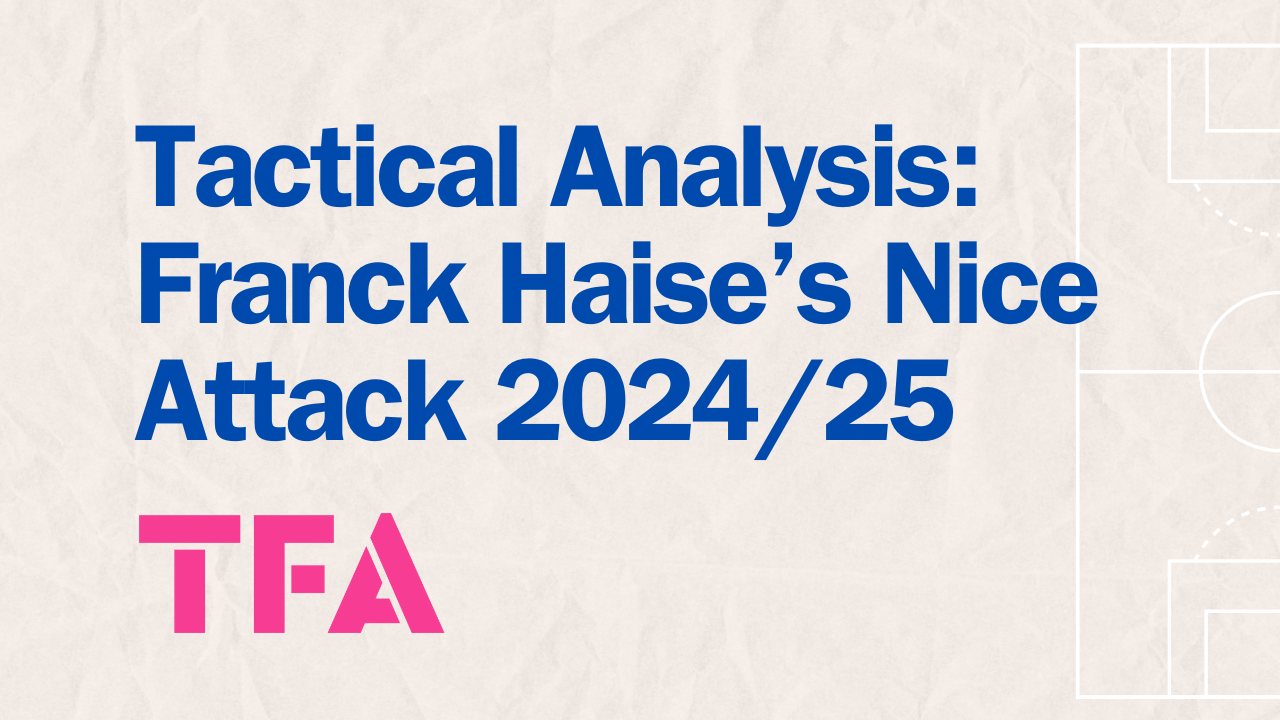




Comments